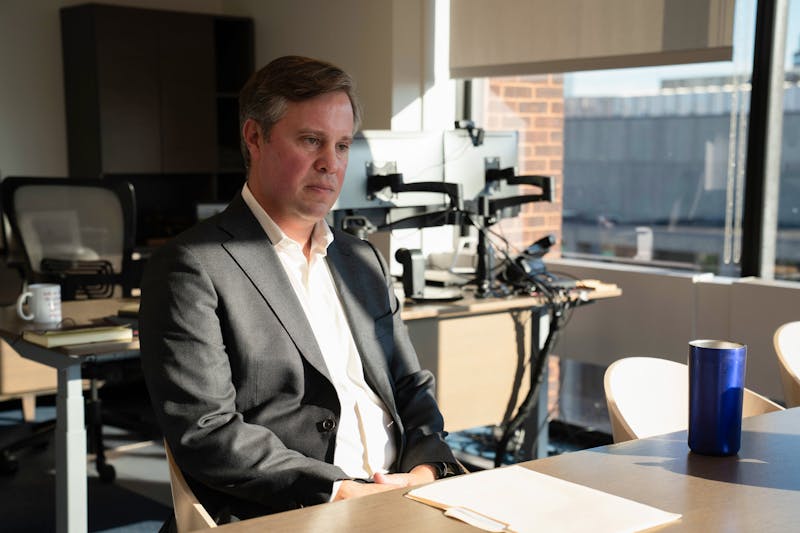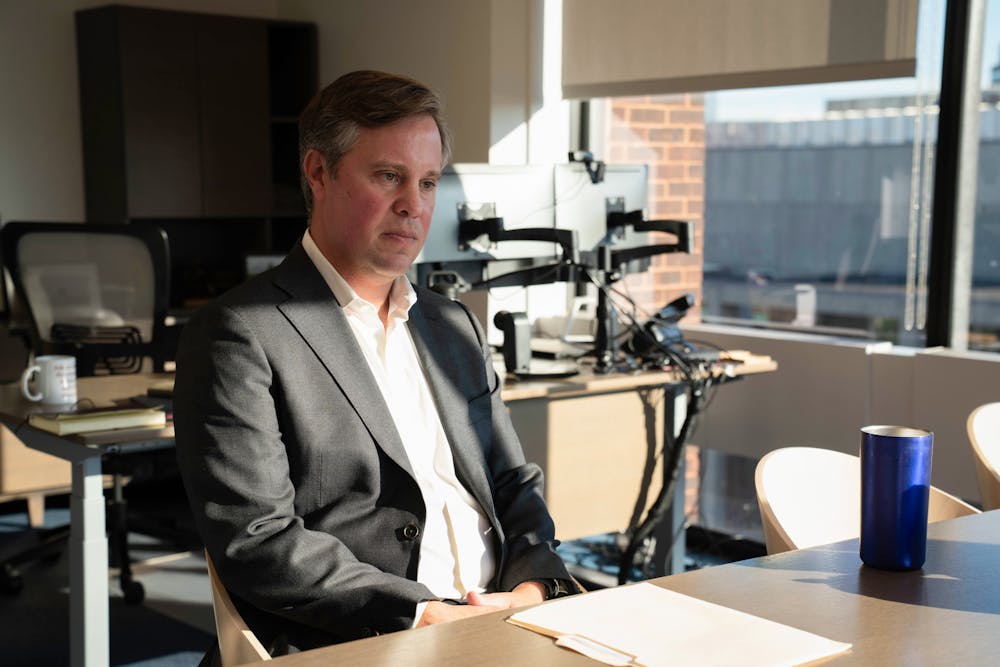Mark Dingfield has served as the University’s executive vice president.
Credit: Ebunoluwa Adesida
Two months since joining Penn’s central administration as executive vice president, Mark Dingfield sat down with The Daily Pennsylvanian to discuss the stability of the University’s finances, research infrastructure, and governance in the face of federal uncertainty.
Dingfield began his term as Penn’s chief financial officer in August, after serving as the University’s vice president of finance and treasurer for almost three years. He described his new role as an effort to maintain the University’s momentum — a mission that requires flexibility amid an evolving landscape of federal policies and financial stress.
“It’s easy for an institution that’s been around as long as we have to do the same things in the same way for decades,” Dingfield said. “We let things work the same way for a decade, we figure out that they don’t work as well, we do a large project to try to fix it, and then, we wait another decade.”
Dingfield highlighted the “need to be constantly adapting” as essential to Penn’s identity as an “imperfect but self-improving” institution. He pointed to the University’s response to the COVID-19 pandemic as an example of how moments of crisis can accelerate innovation.
“It was a horrible time for many reasons, but also as an institution, it allowed us to work … on a set of shared goals that we rarely had to respond to that quickly,” Dingfield said. “The lesson I took from that was we as a University actually can respond to things in a coordinated way.”
He added that Penn “might be able to replicate” that approach in response to other constraints, including the potential loss of federal research funding.
According to Dingfield, Penn’s administration “has been pretty principled” while handling new policies from the White House. He emphasized Penn President Larry Jameson’s attempts to mitigate funding uncertainty by “gain[ing] efficiencies in areas that don’t affect students or … faculty.”
In July, Jameson announced Penn’s settlement with the Department of Education over Title IX violations. Following the University’s compliance, the federal government released $175 million in previously frozen federal funding.
“We’ve done a really good job … both trying to prepare and respond to federal policies in a way that preserves our core mission, including the services and support we provide to students,” Dingfield continued.
He pointed to Penn’s expanded financial aid initiative — the Quaker Commitment — as evidence of the durability of University-wide priorities despite financial insecurity. The new policy removed the value of a family’s primary home when calculating financial aid eligibility and raised the income threshold for families eligible to receive full-tuition scholarships from $140,000 to $200,000 with typical assets.
Dingfield led the charge for expanded financial aid during his previous role and described the impact as “dramatic” among students.
“We’ve started to get the first year of data back, [and] we have about 660 students who have benefited from the two major changes that we made with the Quaker Commitment,” he said.
He also mentioned his hope to “further expand the affordability of a Penn tuition” despite the possibility of a federal endowment tax and other external pressures.
“I know that the headline sticker price gets a lot of attention out there in the media, but I think we really have to do a better job communicating,” Dingfield said. “Roughly 50% of our students get financial aid, and those packages are becoming increasingly generous, so the net price after financial aid is actually decreasing.”
In addition to maintaining student programs, Dingfield underscored the stability of Penn Medicine and research infrastructure as key to developing the University’s response to federal action.
“We are a single legal and financial entity — the health system and the academic component together — but we operate our finances fairly independently from one another,” he said. “That being said, policies that affect the health system have effects on the University.”
Dingfield reiterated that funding losses, including “a major cut to Medicaid or other areas of support,” require close monitoring and “conversation with the health system leadership.”
He added that “outside credit rating agencies also look at [Penn and Penn Med] as one single entity,” meaning that “if the health system or the University is not performing well … it affects our ability to borrow at certain rates.”
According to Dingfield, this poses a challenge for the University, which frequently borrows from the debt market to ensure “sufficient cash and liquidity to support our ongoing operations” during times of financial uncertainty.
Regarding Penn’s “research enterprise,” Dingfield also addressed the facilities and administrative rate Penn receives on sponsored research, which sustains “building operation and maintenance costs” along with “the people that support … clinical trials or environmental health and radiation safety.”
“If [the facilities and administrative rate] were to be diminished significantly, it would affect our ability to pay for those services and that infrastructure at the same level that we do today,” he said.
In February, the National Institutes of Health implemented a 15% cap on indirect F&A costs, with the potential to cost Penn $240 million. While a judge temporarily halted the changes following a lawsuit brought by Penn and 12 other universities against the NIH, University researchers have continued to describe research difficulties.
Soon after, Jameson wrote to the Penn community to describe the threat of the funding cap.
Sign up for our newsletter
Get our newsletter, DP Daybreak, delivered to your inbox every weekday morning.
“In periods of uncertainty, the importance of communicating more actually increases,” Dingfield said. “Absent hearing from University leaders about what is known and what is unknown can increase the anxiety about how we’re responding to it.”
He also reflected on Penn’s historical ability to successfully emerge from “period of real financial distress.”
“It’s not what are we going to do for the next six months or even the next 12 months,” Dingfield said. “It’s how do we make sure that — over the next five, 10, 20 years — we are putting ourselves in a position to be even stronger as an institution.”
The Daily Pennsylvanian is an independent, student-run newspaper. Please consider making a donation to support the coverage that shapes the University. Your generosity ensures a future of strong journalism at Penn.

